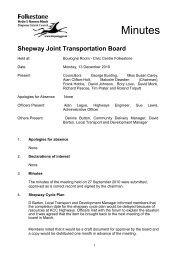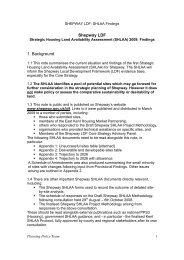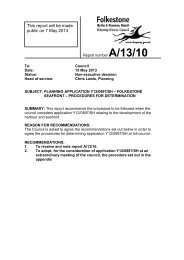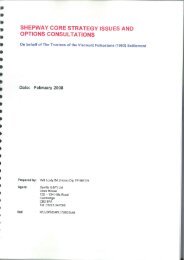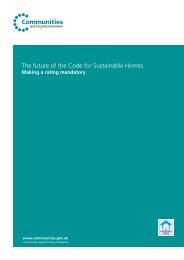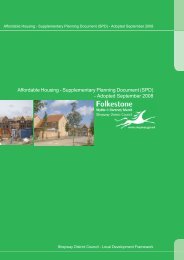Saltwood Conservation Area Appraisal part 1 - Shepway District ...
Saltwood Conservation Area Appraisal part 1 - Shepway District ...
Saltwood Conservation Area Appraisal part 1 - Shepway District ...
You also want an ePaper? Increase the reach of your titles
YUMPU automatically turns print PDFs into web optimized ePapers that Google loves.
SALTWOOD CONSERVATION AREA APPRAISAL<br />
38 In the reign of Henry II the castle was rebuilt by the Lord Warden of the Cinque<br />
Ports Henry d’Essex who undertook further fortification. Essex fell out of favour<br />
with Henry in 1163. His estates were confiscated and <strong>Saltwood</strong> Castle passed to<br />
Ranulf de Broc, opponent of Thomas Becket, Archbishop of Canterbury.<br />
39 The death of Becket was plotted at <strong>Saltwood</strong> Castle. Henry II had appointed<br />
Becket Archbishop, expecting him to take the king’s <strong>part</strong> with the Church. Instead,<br />
Becket assumed devout Christian principles. Henry reacted by giving <strong>Saltwood</strong> to<br />
Becket’s enemy Ranulf de Broc and exiling Becket to France. Despite being<br />
allowed to return, Becket’s independent thought continued to incur Henry’s wrath.<br />
40 Meanwhile, in France, four Knights, Reginald Fitz Urse, Hugo de Moreville, William<br />
de Tracy, and Richard le Breton overheard Henry’s outburst of anger at the<br />
behaviour of Becket. Henry uttered his famous words “of the caitiffs who eat my<br />
bread are there none to free me of this turbulent priest?” The knights crossed from<br />
France and stayed as a guest of de Broc at <strong>Saltwood</strong>, where they plotted Beckets’<br />
murder. Leaving <strong>Saltwood</strong>, they travelled along Stone Street, calling at Lympne<br />
Castle, where they believed Becket was staying. Finding him not at home, they<br />
continued to Canterbury, murdered Becket and returned to <strong>Saltwood</strong>.<br />
41 <strong>Saltwood</strong> returned into ecclesiastical ownership when Archbishop Courtney took up<br />
residence. He implemented a costly rebuilding programme comprising the outer<br />
bailey and the gatehouse which bears his Coat of Arms. Following damage caused<br />
by an earthquake in 1380 it was restored. State rooms and keep were added. The<br />
gateway was modeled on Westgate in Canterbury. When he was in residence the<br />
Archbishop of Canterbury had a suite of rooms in the main Gate House. Priests<br />
who lived permanently at <strong>Saltwood</strong> were lodged on the south and west side where<br />
the great hall, library and secret garden are now situated.<br />
42 Thomas Cranmer was the last ecclesiastical occupant. He was known as the<br />
scholar who produced the Book of Common Prayer, presided over the fate of some<br />
of Henry VIII’s wives and was eventually burned alive for heresy by Mary I in 1556.<br />
43 <strong>Saltwood</strong> was given to Henry VIII by Archbishop Cranmer following the dissolution<br />
of the monasteries. From then it passed into private hands as a gift to the<br />
Knatchbull family from Queen Elizabeth 1.<br />
44 The castle fell into bad repair and following the Civil War the gardens were set out<br />
by a rector James Croft who imported many plants and shrubs. For most of the<br />
C19 it was the home of the Deedes family. The gate house forms the residential<br />
unit. The journalist Bill Deedes was born there and describes it as austere and<br />
unfriendly.<br />
45 In the latter <strong>part</strong> of the C20 the castle became the home of art historian Lord<br />
Kenneth Clark who wrote the book ‘Civilisation’. Following his death it became the<br />
home of his son Alan Clark, MP and diarist, who is buried in the grounds.<br />
46 The church of St Peter and St Paul was mother church to St Leonard’s in Hythe<br />
before their separation in 1844. The chancel and nave date from 1100, the tower<br />
was built in 1220 and the chancel was added to in C13. Together the church,<br />
<strong>Saltwood</strong> Castle, Lympne Castle, St Leonard’s and ecclesiastical buildings in Hythe<br />
belonged to the See of Canterbury and their histories are a linked.<br />
<strong>Conservation</strong> Architecture & Planning 7




